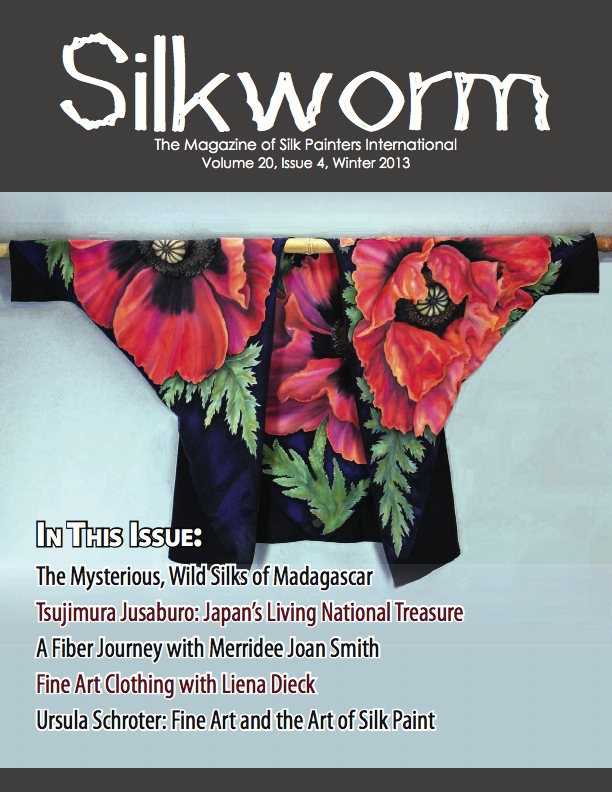|
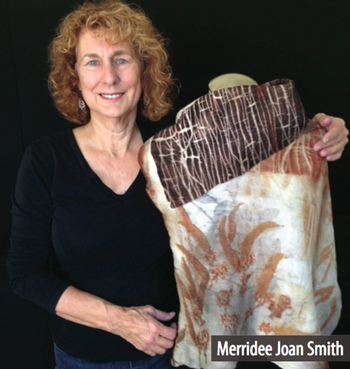
|
A Fiber Journey with Merridee Joan Smith
by Merridee Joan Smith and Mary Grace Umlauf
Although a chemist by education and profession, I have loved fiber since childhood and have also been inspired by natural surroundings including earth forms, flowers, texture, color and pattern. Approaching retirement from my career as a forensic scientist, my interest in pursuing fiber arts was unleashed. And so my journey in fiber began in earnest.
It was my good fortune to have Susan Louise Moyer introduce me to the joys of silk painting when she taught a workshop near my home (not a bad way to start!). I was immediately hooked. We all know the wonder we feel when dye is brushed onto silk; the movement, color and vibrancy of the dye and silk are magical.
As I began to paint and focus on a representational style, I learned that serious work requires a strong foundation in the concepts of art.
I began taking drawing, water- color and fine art classes in design, composition and color theory. I also wanted to know more about the techniques and processes in silk painting – there are so many and they can add so much to the work. (To read more, go to Vol. 20, Issue No. 4.)
|
|
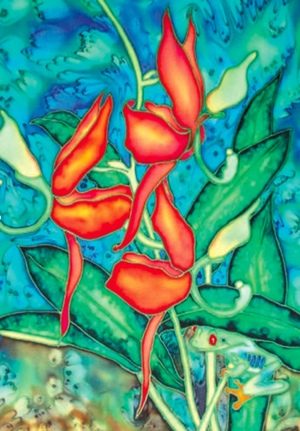
by Ursula Schroter
|
Ursula Schroter: Fine Art and the Art of Silk Paint
by Mary Umlauf
Silk painting is still a relatively new art form in the United States. This is one reason why several of the most experienced SPIN artists discovered silk paint- ing in Europe. Ursula Schroter is one of our accomplished SPIN members originally educated in Germany where this art form was very popular in the 1980’s and 90’s.
“In Germany, you could go to the art supply stores and there would be a whole wall of books about silk painting, tools, dyes and silk blanks. Classes in silk painting had wait- ing lists! It was such a shock when I first came to Canada and later to the US; I had great difficulty locating products that I needed for silk painting at that time. Of course, by now, the Internet has helped but I still have to buy from multiple online stores for my work.”
Ursula readily admits that she did not aspire to be an artist or a silk painter in her youth; she was able to invest time in exploring her hobby while raising her children. Today, Ursula Schroter is a highly visible and productive silk painter in California. Ursula is an active member of the Carlsbad-Oceanside Art League, the Escondido Art Association, the San Diego Silk Guild, and Silk Painters International (SPIN), of course.
Like many professional silk painters, Ursula has had to edu- cate other artists, galleries, and art judges about the nature of her work. Ursula has found a strong middle ground to validate that her work is indeed fine art by using terminology that is more accepted in the art community. (To read more, go to Vol. 20, Issue No. 4.)
|
|
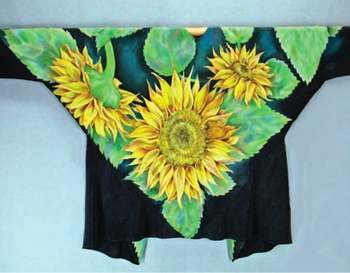
|
Fine Art Clothing by Liena Dieck
Silk Painting Made into Wearable Art,
by Mary Umlauf
One of the special features of the art of silk painting is that we can also wear it. Liena Dieck is one of SPIN’s own Master Silk Painters (MSP) who is also known for creating wearable silk art as well as fine art on silk.
Liena is a native Russian who graduated from Lomonosov Moscow State University and studied trompe l’oeil at Paier College of Art, Hamden, CT. Although she shows her silk paintings at annual shows in New York with the Catharine Lorillard Wolfe Art Club and the American Artists’ Professional League, the public response to her wearable art is remarkable.
When visiting her home country, women will follow her down the street to examine what she is wearing. Some women actually stop her and ask where she found that beautiful jacket, blouse or wrap that she created herself. However, she has developed a following of faithful patrons who come to the boutique events where Liena shows garments. (To read more, go to Vol. 20, Issue No. 4.)
|
|
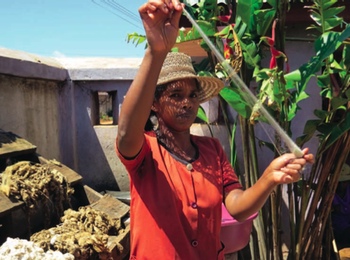
|
Mysterious, Wild Silk
By Jean-Louis Mireault
It was a surprise trip. No one knew where we were going except my wife, the group attendant. It was only at the airport that we discovered our destination. Opening our airplane ticket, we read: Montreal to Paris and then Paris to Antananarivo. Where is Antananarivo?
Oh yes! I remember this bizarre city name from a college geogra- phy course. It is in Madagascar or Mada, as the residents call it. The Tropic of Capricorn passes through this island situated off the south east coast of Africa in the Indian Ocean. The population of Mada is ethnically Indonesian with a small contribution from Africa.
Like the Galapagos Islands, it was isolated during evolution that resulted in unusual wildlife and unique flora. Mada is known for being home to small primates called lemurs; the ring-tailed lemur (see photo) lives in female dominated groups. (To read more, go to Vol. 20, Issue No. 4.)
|
